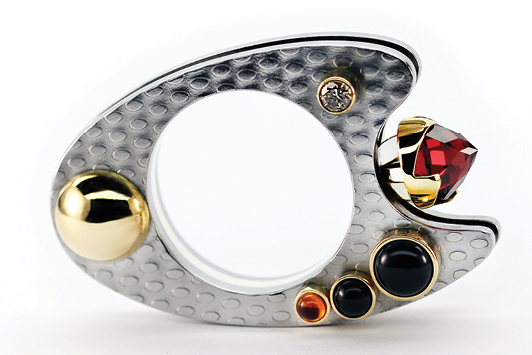
The earliest gemstone cuts not only help to date a piece, but deliver insight into the evolution of stonecutting itself. Such is the case with rose cut stones. This early 16th-century stone shape was first created to retain as much of the original rough as possible. Cutters would make flat-bottomed stones with a few simple facets converging to a center point, mirroring the stone’s natural form.
Antique rose-cut gems are most always slightly off-symmetry owing to their hand-cut nature. During the era of their greatest popularity, this shape was considered the best reflector of candlelight — the only source of evening illumination at the time.
Today, of course, we have a greater understanding of how light behaves with polished stones, so cutting styles can now optimize their scintillation and brilliance. But while those achievements are laudable, a yearning persists for older jewelry and stone shapes that remind collectors that the piece first began in the hand of an artisan. A recent resurgence of affection for rose-cut gems proves that some things trump perfection.
“With both diamonds and colored stones, the rose cut exhibits a hand-wrought nature that connects it to a real human stone polisher,” affirms Dori Paul, co-owner of antique and period jewelry wholesaler eFiligree.com. “Their slight imperfections are the very thing that endears [these stones to] sophisticated jewelry fans.”
Easy to adapt
It’s not just collectors and buyers who see the appeal. Stonecutter and gemologist Peter Torraca, owner of Torraca Gem Cutting, says he loves “the deep historical connection of making rose cuts. Lapidaries from centuries ago might not know
my tools, but they would certainly recognize the rose cut pattern.”
Torraca finds it amazing that “this gemstone faceting pattern is still in demand and being used in new ways by designers.”
With diamonds, a cutter aims for light penetration into the stone, and for it to reflect back from as many different angles as possible. With colored stones, it’s all about getting the color to dazzle the eye by reflecting off the gem’s top facets. Rose cuts succeed well in this latter regard.
“The most attractive feature of a rose cut is its versatility,” Torraca explains. “I’m only concerned with surface reflections, so thin, dark, or even included rough are all usable, perhaps even desirable for a rose cut.” That’s because rose cuts don’t require a pavilion, and their shallowness makes inclusions less noticeable.
The rose cut is easily adaptable to any outline, he adds, including free-form shapes, although classic rounds are the most popular.
Designers’ choice
Today’s jewelry artists are using rose-cut gems to breathe new life into their collections.
One of them is Jennifer Dawes, owner of Jennifer Dawes Design, who caters to an artistic clientele. “I have been using rose cuts for about 15 years,” she says. “I’m attracted to their watery refraction and low profile.” Beyond that, they pair perfectly with her style: “My work has an ancient and organic quality, and rose cuts enhance this aesthetic.”
Another fan is Claudio Pino of Pino Designs in Montreal, Canada, who specializes in free-form jewelry and original gemstone shapes in his exclusive collections. “I love working with rose cuts because of their unique geometry,” he declares. “I find them very inspiring.” In his work, there is a symbiosis among the metals, designs and stones, all of which are part of his storytelling process. “My settings are created to fit my design, and my designs are inspired by the selected stone and its cut.”
Vintage appeal
The rose cut often features prominently in rings and pendants, and that’s where modern jewelry fans frequently catch their first glimpse of these captivating stones.
“Over the past few years, I’ve seen a lot of rose-cut styles appearing in finished jewelry at all price points and qualities,” Torraca reflects. “I’ve been commissioned to craft rose-cut designs in everything from colorless [cubic zirconia (CZ)] to ethically sourced Tanzanian ruby.”
Pino also sees customer enthusiasm for this shape. “Modern rose cuts always surprise my clients. I think people love their uniqueness, vintage appeal, and also their ancient roots and history.... I have to say that modern rose cuts are in very high demand right now.”
The jewelry lover seeking atypical pieces may fall in love with rose cuts even without knowing about their past. “My customers love the rustic honesty of my metalsmithing,” says Dawes, who puts her own personal touch on each piece. “Rose cuts are also this way. They are all hand-cut, thus appearing rustic and natural. My clients are non-ostentatious, so this cut appeals to them on a sensory level.”
Any colored gem can be polished into a rose cut, but there’s something about a rosy-hued stone getting this beauty treatment, Torraca says. “This historic-nostalgic streak keeps the red garnet as the definitive rose-cut colored stone. But to my eye, any gemstone that has rich color and good transparency makes for a fine rose cut.”
Article from the Rapaport Magazine - April 2021. To subscribe click here.